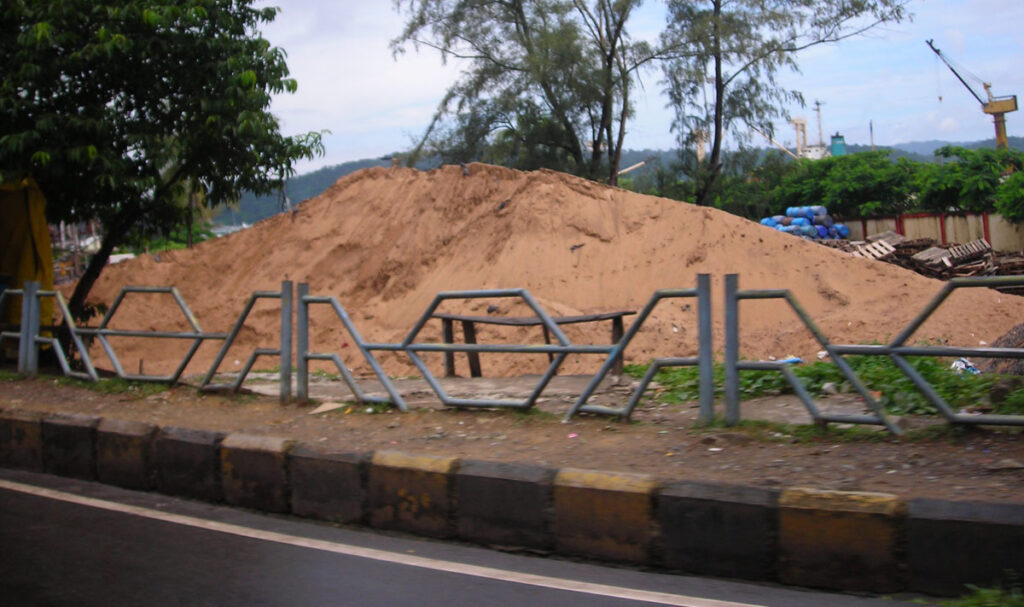Land registration process in the Islands, which was one of the best in the country, had over the time turned into a breeding ground of malpractices due to addition of unnecessary processes. And, now the latest cure seems to be catastrophe in the making.
By Sanjay Balan
‘Land Ahoy’- is a popular exclamation by a sailor shouted in excitement on sighting of land while at sea!
However, a land owner of the island territory remains all at sea during his lifetime suffering nightmares largely on account of introduction of many restrictive (read unreasonable and citizen unfriendly) regulations, orders, the “Master” Plan restrictions, over-complication of simple processes etc.
The sufferings pass on by inheritance to the legal heirs too! All this has made life of a land owner pitiable in the territory.
Non appreciation of the ground realities are the basic problem for various land issues in this territory.
And on 05th November, 2020, when I read the front page news ‘The Daily Telegrams’ captioned ‘Transparency and Accountability in Registration Process’, I could not but help getting elated. Some of the steps being tried to ease life of the land holder is worth appreciating and I wish all these steps become successful in the long run. There will be teething issues but the same can be corrected when there is a will.
Having said that, for me, ‘Registration’ of Deeds, especially land transactions, in the territory was always one of the best in the Country. This coupled with the land record, titling system followed in the territory, provided little scope for malpractices unlike many other places in the Country.
However, overtime systemic flaws got built into the system due to unwanted introductions not required under law. This made processes very cumbersome, timeline for delivery took a hit and as is the case normally, with no accountability for delays, all these give perfect breeding ground for various types of malpractices.
This article is an attempt to look into various aspects and solutions for removing them.
Unlike many other parts of our country, the land law of the territory is linked to Registration Act making it incumbent upon the sub-registrar to ensure that the deed satisfies ‘ONE’ repeat only ‘ONE’ section out of the 212 Sections in the Land Regulation. For verifying this, the only requirement would be to check the latest record entry and map, or no dues certificate, or non-encumbrance certificate, or the copy of sale permission in case of non-agriculture land.
Then the sub-registrar has to merely follow the norms laid down under Registration Act. All actions for registration can easily be completed within a period of three days from its submission to its registration. Other types of deeds are much simpler than these for registering. The Deputy Commissioner, South Andaman had in fact issued a public notice in the year 2018 stating the same too!
These aspects need to be incorporated in any online structure so that ease of delivery in service is ensured – both for the officers concerned as well as the citizen.
However, today the larger issue is- the enhancement of Stamp duty and Registration Fees as well as the Administrative order fixing the circle rates.
Registration of documents across territory was stopped without any announcement sometime during July, 2019 (much before Corona Lockdown). There was hue and cry in the public but no reasons were ever assigned for such closure.
As per information more than 200 odd deeds were pending registration at the relevant point of time. Later on it became clear that the unannounced closure of registrations was to enhance Stamp Duty and Registration Charges and to issue Circle Rate for land, a progressive step.
As such an NGO vide their letter in September, 2019 gave their suggestions by clearly suggesting not to implement the same retrospectively lest it becomes a cause for unnecessary litigations and also to follow the statute while doing so.
The letter clearly made out a case that the actual issue was pertaining to delay in registration of land and also requested for increasing the number of sub-registrars in the territory, which have been static over decades.
On 1st November, 2019 (much before Corona Lockdown), a news item appeared in The Daily Telegrams regarding ‘resumption’ of property registration. Simultaneously, the enhanced rates of Stamp Duty, Registrations Fees and Administrative Order as regards Circle Rate was also notified by the Administration.
The sub-registrars started returning the deeds already submitted before notifications were issued and as visualised, Court cases became the order of the day.
Political parties and various citizens started agitating against the changes made as it was like ‘double whammy’ putting the citizen in severe hardships.
Present Stamp duty charges here must be one of the highest in the Country. The reason for increasing the same from erstwhile 1.5% to 6 %, a quantum jump is not understood. In all likelihood the thought behind it might be for increasing ‘revenue’ of the UT!
One can only shrug it off with a smile if this was the thought process because of the shallowness of the thought process.
As a first step to undertake the exercise the changes in registration process, vide Notification No. 276 dated 22-10-2019 A & N Islands Stamp (Prevention of Undervaluation of Instruments) Rules, 2019 was notified.
This is supposed to have been issued by exercising powers under Section 75 of the Indian Stamp Act. This Section in the Act provides power to the ‘State Government’ to make rules.

Since the Island territory is a UT, State Government for this purpose will be Central Government unless otherwise expressly UT Administration is also categorised as State Government in the said Act or Powers have been conferred upon the Administrator. The Notification issued does not divulge this aspect and hence, the Notification will naturally will be a matter of judicial scrutiny.
Further, the said Rule is almost in line with the Rules in force in West Bengal.
The Rule made for West Bengal draws its powers, as regards determination of market value, from ‘West Bengal Specific Amendment’ in the Stamp Act (insertion as Section 2(16 B) in the principle Act). This amendment will apply only to West Bengal and drawing its powers from here in the Act, the West Bengal Rules lays down the manner in which a sub registrar can determine the market value.
It has also to be understood that the Stamp Act is basically relating to stamps only and does not provide power to fix rates of land. In the newly notified Rules for Island territory on the other hand, the Rule 4 provides power to Administrator to fix land rates and that too by an Administrative order.
The framers of the Rule seem to have lost sight of the fact that the land law (special/local law) shall hold precedence in such matters wherein there is a specific provision for continuous inquiry into value of land (Section 45 of the land Regulation).
The Rules framed there under also provide yearly Notification of these rates (Rules 28 to 36). This is legal recourse that is provided under land regulation of the territory to arrive at land rates. Hence, an Administrative order on circle rates can be tested for its legality.
Even otherwise another interesting aspect is that the Rule 4(b) of the newly notified Stamp Rules clearly stipulates that the Administrator may at his discretion place the circle rates in public domain for a period of 15 days for inviting suggestions and objections and thereafter take a decision on those suggestions/objections.
Unfortunately, even though such fixation of rates was being undertaken for the first time in the territory (must add that a much needed step), but it was not thought prudent to elicit responses from the stakeholders prior to finalising it.
This led to rates in many areas being many a times higher than actual market rate. So much so that in cases the stamp duty itself comes to almost the market rate for the land!
Even if a person pays the stamp duty as per circle rate, he can only show the actual amount he has received, which will be much less than the amount calculated by multiplying with Circle rate. Thus, he exposes himself to be hauled up for undervaluation. It is also going to create problems for the Administration during acquisition proceedings and the Banks for extending loans etc.
Moreover considering the manner of settlements / fluctuation of rates even in a small compact locality due to location of land etc, a minimum and maximum rate needed to spelt out. Therefore, a review of Circle rates may have to be considered before long.

Be that as it may, the fact remains that the higher circle rate coupled with a quantum leap in stamp duty and registration fee increase has placed tremendous burden on a seller. Even if a person intends to gift land to his children during his lifetime to avoid disputes after his demise, he/she will now have to shell out a fortune as duty and fees. This is not fair at all.
As a result, now parties will start other adhoc practices for sale of land and this will naturally lead to a situation we now see in different states. So the basic intent of increasing revenue of UT or putting a stop to mischievous practices would be defeated. It will rather lead to more litigation in due course and these litigations will overburden the system.
The land records will slowly lose its meaning and it will become a field day for shortcuts and adhoc practices in sale purchase etc. Not at all a good sign!
It is always better to act with foresight rather than getting intelligent in hindsight and that too when the damage has been irretrievably done.
The government of India also recognises that real estate is the driver of the economy in many ways. Packages to provide impetus have been pumped in. Many states have reduced stamp duty to encourage economic upswing. Even a Parliamentary Committee had in the past suggested reduction of stamp duty to a minimal level.
Our island economy like our environment and ecology is fragile. Therefore, in the current times it may be imperative to have a relook at these notifications urgently and take corrective steps.